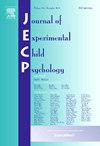三岁和四岁的孩子代表着相互排斥的可能身份。
IF 2
2区 心理学
Q3 PSYCHOLOGY, DEVELOPMENTAL
引用次数: 0
摘要
儿童如何思考和计划未来可能发生的事件的可能结果?以往研究儿童思考相互排斥可能性的能力的工作主要集中在儿童对一种可能性--物体的可能位置--的推理上。在这里,我们研究了儿童对另一种可能性--相互排斥的可能身份--的推理。在两个实验中(N = 201 名美国 3-4 岁儿童),儿童被告知两个动物角色(如兔子和猴子)将轮流从游乐场的滑梯上滑下。孩子们被告知,一旦滑到滑梯底部,动物们就想吃自己最喜欢的食物(如胡萝卜和香蕉)。在 "身份不明确 "条件下,我们告诉儿童将滑下来的动物的身份。在 "身份不明确 "条件下,我们告诉儿童不知道哪种动物会先滑下来。为了考察儿童对可能身份的表征,我们要求儿童 "准备好零食"。我们发现,在 "身份不明确 "条件下,儿童只选择了其中一种零食(即他们被告知会滑下来的动物最喜欢的零食),而在 "身份模糊 "条件下,儿童同时选择了两种零食,这表明他们同时考虑了两种可能的身份。这些结果扩展了模态推理发展的文献,将可能身份的推理也包括在内,并表明3岁的儿童就可能具备这种能力。本文章由计算机程序翻译,如有差异,请以英文原文为准。
Three- and four-year-old children represent mutually exclusive possible identities
How do children think about and plan for possible outcomes of events that could happen in the future? Previous work that has investigated children’s ability to think about mutually exclusive possibilities has largely focused on children’s reasoning about one type of possibility—the possible locations of an object. Here, we investigated children’s reasoning about another type of possibility—mutually exclusive possible identities. In two experiments (N = 201 U.S. 3- and 4-year-olds), children were told that two animal characters (e.g., a bunny and a monkey) were going to take turns sliding down a playground slide. Children were told that the animals wanted to eat their favorite foods (e.g., carrots and bananas, respectively) as soon as they got to the bottom of the slide. In an Unambiguous Identity condition, we told children the identity of the animal that would slide down. In an Ambiguous Identity condition, we told children that which animal would slide down first was unknown. To examine children’s representations of possible identities, we asked children to “get snack ready.” We found that children in the Unambiguous Identity condition selected only one of the snacks (i.e., the favorite snack of the animal they were told would slide down), whereas children in the Ambiguous Identity condition selected both snacks, suggesting that they were accounting for both possible identities. These results extend the literature on the development of modal reasoning to include reasoning about possible identities and suggest that this ability may be available to children as young as 3 years.
求助全文
通过发布文献求助,成功后即可免费获取论文全文。
去求助
来源期刊

Journal of Experimental Child Psychology
Multiple-
CiteScore
4.50
自引率
7.70%
发文量
190
期刊介绍:
The Journal of Experimental Child Psychology is an excellent source of information concerning all aspects of the development of children. It includes empirical psychological research on cognitive, social/emotional, and physical development. In addition, the journal periodically publishes Special Topic issues.
 求助内容:
求助内容: 应助结果提醒方式:
应助结果提醒方式:


